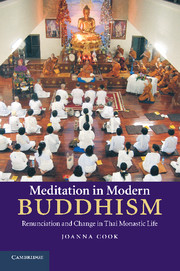Book contents
- Frontmatter
- Contents
- Acknowledgements
- List of map and figures
- Notes on language
- Map 1 Map of Thailand
- 1 Meditation and monasticism: making the ascetic self in Thailand
- 2 Meditation and religious reform
- 3 The monastic community: duty and structure
- 4 Meditation as ethical imperative
- 5 Language and meditation
- 6 Monastic duty, mindfulness and cognitive space
- 7 Money, mae chee and reciprocity
- 8 Hierarchy, gender and mindfulness
- 9 Monasticization and the ascetic interiority of non-self
- Appendix: Ordination transcript for an eight-precept nun (mae chee)
- Bibliography
- Index
3 - The monastic community: duty and structure
Published online by Cambridge University Press: 03 May 2011
- Frontmatter
- Contents
- Acknowledgements
- List of map and figures
- Notes on language
- Map 1 Map of Thailand
- 1 Meditation and monasticism: making the ascetic self in Thailand
- 2 Meditation and religious reform
- 3 The monastic community: duty and structure
- 4 Meditation as ethical imperative
- 5 Language and meditation
- 6 Monastic duty, mindfulness and cognitive space
- 7 Money, mae chee and reciprocity
- 8 Hierarchy, gender and mindfulness
- 9 Monasticization and the ascetic interiority of non-self
- Appendix: Ordination transcript for an eight-precept nun (mae chee)
- Bibliography
- Index
Summary
I flew into Chiang Mai late one night in October 2003. As I waited to collect my luggage on the carousel I could see a group of half a dozen monks and mae chee waiting for me through the doors to the arrival hall; sitting in two separate groups, the respective orange and white of their robes created blocks of colour amidst the chaos of the airport. I was greeted with huge smiles, myself and my friends meeting each other with happy wai's. I was returning to the monastery after an absence of a few years to ordain as a mae chee and spend fifteen months conducting participant observation. I was whisked through the streets of Chiang Mai high up in the comfort of the monastery's air-conditioned mini-van. I enquired about the health of monks and mae chee. It had been a few years since my last three-month stay in Wat Bonamron and I learnt that my arrival had been much anticipated and talked about. We rolled into the sleeping monastery and I was shown to my room in the mae chee quarter behind the kitchen and left for the evening. My room was basic but very comfortable with a wooden bed, a bedroll, blanket and pillow, a Buddha image and a bathroom. I unpacked my bag as the monastery slept, listened to the occasional dog barking at the night and the industry of the insects in the bamboo outside my door.
- Type
- Chapter
- Information
- Meditation in Modern BuddhismRenunciation and Change in Thai Monastic Life, pp. 51 - 69Publisher: Cambridge University PressPrint publication year: 2010



